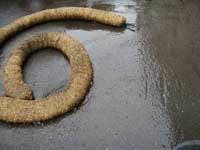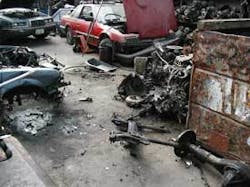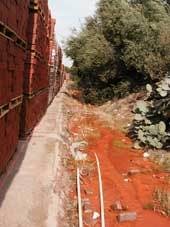Hidden Benefits of Stormwater Inspections
by Robert Naeser and Scott Slamal
Stormwater compliance inspections by regulatory agency staff are anticipated as much as a trip to the dentist for a root canal. Recognizing this, this article postulates that stormwater compliance inspections can have positive benefits for facility representatives from increased compliance awareness to increased corporate participation in stormwater compliance activities.
In an effort to gauge the impact of routine compliance inspections on facility performance, Tetra Tech, EPA Region 9, and the Los Angeles Regional Water Quality Control Board selected 101 industrial facilities for two rounds of inspections to determine the facilities’ compliance with California’s Industrial Storm Water General Permit. The same 101 facilities were re-inspected, unannounced, approximately six months after the initial inspection and after receiving a follow-up letter from the regional board.
Big Improvements
Table 1 shows significant improvements in facility compliance rates from the first to the second inspection. Most important from the perspective of improvements to stormwater quality, the number of facilities that had adequately implemented stormwater best management practices (BMPs) went from 19% to 75%.
Table 2 presents changes to overall facility ratings between the first and second inspection. The number of facilities determined by the inspector to present a threat to stormwater quality (“1” rating) decreased from 23 to 6 facilities. Equally impressive were the 53 facilities determined to be in general permit compliance (“3” rating) after the second inspection, up from zero in the first round. Overall, 66 facilities improved by at least one rating level between the first and second inspection, 27 remained unchanged, four worsened, and four were no longer operating at the same address.
Follow-up Benefits
On the surface, it would appear that increased compliance rates were directly attributable to the inspection and follow-up response from the regional board. So where are the hidden benefits? First, like many states, California charges a fee for facilities covered under its Industrial Storm Water General Permit (currently $830/year). The facility has invested significant resources in stormwater BMPs, stormwater plan development, and sampling and is interested in finding out if their program meets regulatory requirements. Second, facility representatives often had compliance questions that were best answered through a regulatory field visit. For example, one facility was discharging contact cooling water from metal working to a storm drain. Prior to the first inspection, facility representatives were unaware their activities were an unauthorized non-stormwater discharge. Once this was understood, they re-engineered the facility’s process to discharge to a lined retention basin.
Beyond the obvious threat of a large monetary penalty for noncompliance, how can regulatory attention work to the facility’s benefit? On multiple occasions facility representatives stated that receipt of the inspection report allowed them to obtain additional funds from the corporate office for implementation of the stormwater program (i.e., BMP implementation or additional staffing). The inspection report enabled a benefit/cost analysis that demonstrated investment in the stormwater program, compared to potential financial penalties, was positive to the overall bottom line.
Conclusion
Finally, one cannot discount the secondary benefits of a strong regulatory field presence. Frequently, facilities that are inspected will notify their peers that inspections are occurring in the area. This advance notice prompts many facilities to clean up their yards, regardless of whether they’re ultimately inspected, and these cleanup activities do benefit overall water quality and workplace safety.
About the Authors: Robert Naeser and Scott Slamal both work for Tetra Tech Inc., the primary contractor with the U.S. Environmental Protection Agency for site inspections under the National Pollutant Discharge Elimination System (NPDES) permit program which includes oversight of stormwater discharges from industrial users. Contact: 303-921-3674 or [email protected]






